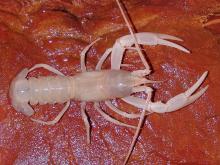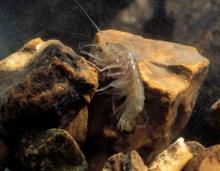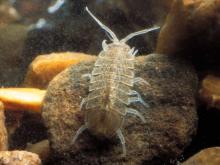Aquatic Invertebrates
Media

Species Types
Scientific Name
Dugesia, Planaria, and other genera
Description
Unlike their parasitic cousins in the flatworm group, turbellarians, or planarians, are tiny carnivores or detritus-eaters that glide smoothly across submerged leaves and other objects.
Media

Species Types
Scientific Name
Orconectes stygocaneyi
Description
One of three species of cave crayfish in Missouri, the Caney Mountain cave crayfish is known from only one location. Like many other cave invertebrates, this species is whitish and is blind.
Media

Species Types
Scientific Name
Species in the crustacean order Amphipoda
Description
Often overlooked by people, but eagerly sought by fish, Missouri’s amphipods resemble shrimplike sowbugs. Scuds live in various aquatic habitats, and several species inhabit caves.
Media

Species Types
Scientific Name
Freshwater members of the crustacean order Isopoda
Description
Everyone knows about terrestrial sowbugs and pillbugs, but many isopod species are aquatic. Missouri has several isopods that live in streams, ponds, rivers, and caves.
Media

Species Types
Scientific Name
Over 20 Missouri species in former subclass Prosobranchia
Description
Gilled snails are one of two main groups of aquatic snails in Missouri (the other group is the "lunged" snails). Gilled snails, or prosobranchs, breathe with gills and possess a hard trapdoor-like operculum. They are most common in the Ozarks.
See Also
About Aquatic Invertebrates in Missouri
Missouri's streams, lakes, and other aquatic habitats hold thousands of kinds of invertebrates — worms, freshwater mussels, snails, crayfish, insects, and other animals without backbones. These creatures are vital links in the aquatic food chain, and their presence and numbers tell us a lot about water quality.





















